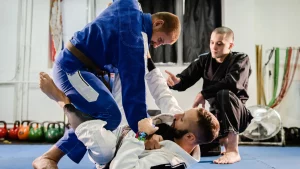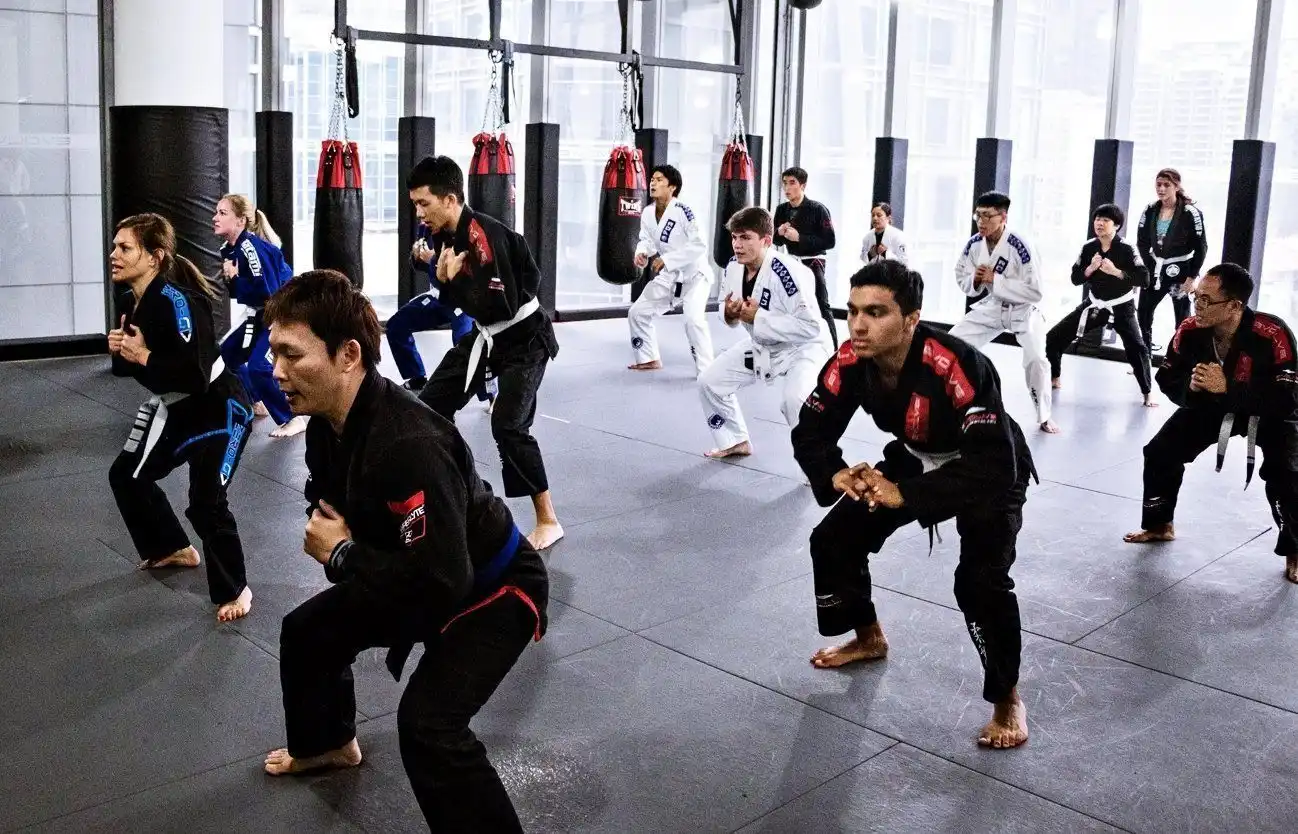In the world of competitive sports, athletes constantly strive to gain an edge over their rivals. For Jiu Jitsu practitioners, a well-structured training plan is crucial for success.
This article presents a step-by-step Jiu Jitsu training plan designed specifically for athletes. By following this plan, athletes can improve their strength, endurance, flexibility, and technique, ultimately enhancing their performance on the mat.
The training plan includes warm-up exercises, targeted drills, sparring sessions, and recovery techniques, all thoroughly explained and demonstrated. Additionally, this article emphasizes the importance of consistency, discipline, and goal-setting in the pursuit of Jiu Jitsu mastery.
Whether you’re a beginner or an experienced practitioner, this tailored Jiu Jitsu training plan can help unlock your full potential and excel in your Jiu Jitsu journey.
Key Takeaways
- A Jiu Jitsu training plan provides structure, direction, and goals for athletes.
- Setting specific, measurable, realistic goals with deadlines helps track progress and provides motivation.
- Fundamentals training is crucial for building a solid foundation and advancing to more advanced techniques.
- Conditioning and strength training, including HIIT and resistance exercises, enhance overall performance on the mat.
The Importance of a Jiu Jitsu Training Plan
Having a well-designed Jiu-Jitsu training plan is crucial for athletes looking to excel in their performance and achieve their full potential.
A Jiu Jitsu training plan provides structure and direction to an athlete’s training routine, helping them to set specific goals and track their progress. It allows athletes to focus on different aspects of their game, such as technique, strength, conditioning, and strategy, ensuring a well-rounded development.
A well-designed plan also helps athletes to avoid burnout and overtraining by incorporating rest days and periodization. Additionally, a training plan helps athletes to stay motivated and disciplined, as they have a clear roadmap to follow.
It provides a sense of belonging and purpose, as athletes work towards improving their skills and competing at higher levels. Overall, a Jiu Jitsu training is essential for athletes who want to maximize their potential and achieve success in their sport.
Setting Goals for Jiu Jitsu Training
To begin the process of setting goals for Jiu Jitsu training, athletes should start by identifying their desired outcomes and objectives. This step is crucial as it provides a clear direction and purpose for their training.
Here are three key points to consider when setting goals for Jiu Jitsu training:
- Specificity: Goals should be specific and clearly defined. Athletes should ask themselves what they want to achieve in their Jiu Jitsu journey, whether it’s mastering a certain technique, winning a championship, or improving overall performance.
- Measurability: Goals should be measurable to track progress and determine success. Athletes can set measurable goals by establishing specific milestones or targets, such as attending a certain number of classes per week or competing in a certain number of tournaments.
- Realistic and Time-bound: Goals should be realistic and achievable within a given timeframe. Athletes should consider their current skill level, physical abilities, and available time for training when setting their goals. Additionally, setting a deadline or timeframe for each goal provides a sense of urgency and motivation.
Building a Solid Foundation: Fundamentals Training
Developing a strong foundation in Jiu Jitsu begins with mastering the fundamentals of the sport. Fundamentals training is an essential component of any Jiu Jitsu training plan, as it lays the groundwork for future growth and success.
During this phase, athletes focus on learning and perfecting the basic techniques, positions, and movements of Jiu Jitsu. This includes understanding proper body positioning, learning how to execute fundamental submissions and escapes, and practicing essential drills and exercises.
Building a solid foundation through fundamentals training not only enhances an athlete’s technical skills but also improves their physical conditioning, coordination, and mental focus. It provides a solid base from which athletes can advance to more advanced techniques and strategies.
Conditioning and Strength Training for Jiu Jitsu
Conditioning and strength training are vital aspects of a comprehensive Jiu Jitsu training plan, as they complement the foundational skills developed in fundamentals training and contribute to an athlete’s overall performance on the mat.
Here are three key components of conditioning and strength training that every Jiu Jitsu athlete should incorporate into their training plan:
- High-intensity interval training (HIIT): HIIT workouts are effective for improving cardiovascular endurance and developing explosive power, which are essential for Jiu Jitsu. Incorporate exercises like sprints, burpees, and kettlebell swings into your training routine.
- Resistance training: Building strength is crucial for Jiu Jitsu. Focus on compound exercises such as squats, deadlifts, and bench presses to target multiple muscle groups and improve overall body strength.
- Core training: A strong core is essential for stability and balance during Jiu Jitsu techniques. Include exercises like planks, Russian twists, and hanging leg raises to strengthen your core muscles.
Drilling Techniques and Strategies
Implementing effective drilling techniques and strategies is crucial for athletes looking to enhance their Jiu Jitsu skills and performance on the mat. Drilling is a fundamental aspect of Jiu Jitsu training that allows athletes to practice and refine their techniques in a controlled environment.

By repeatedly performing specific moves, athletes can develop muscle memory and improve their execution, speed, and accuracy. When it comes to drilling, it’s important to have a structured approach.
Athletes should focus on specific techniques or positions, break them down into smaller components, and practice them repetitively. Additionally, incorporating situational drilling can help athletes simulate real-life scenarios and develop their problem-solving skills.
It’s also beneficial to vary the intensity and pace of drilling to challenge oneself and simulate the unpredictability of a live match. By implementing effective drilling techniques and strategies, athletes can accelerate their progress and become more proficient in Jiu Jitsu.
Putting It All Together: Competition Preparation
Competition preparation is essential for athletes looking to excel in Jiu Jitsu. It involves a comprehensive approach that encompasses physical, mental, and technical aspects of the sport.
To ensure you are fully prepared for competition, consider the following:
- Physical Conditioning: Focus on building strength, endurance, and agility through a combination of weight training, cardiovascular exercises, and sport-specific drills.
- Mental Preparation: Develop mental toughness and resilience through visualization exercises, goal setting, and positive self-talk. It is crucial to stay focused and confident during competition.
- Technical Training: Refine your techniques, study your opponents’ strengths and weaknesses, and strategize accordingly. Practice live sparring sessions to simulate real competition scenarios.
Frequently Asked Questions
How Often Should I Train Jiu Jitsu?
To optimize your progress in jiu jitsu, it is recommended to train consistently. The frequency of your training sessions will depend on your individual goals, abilities, and schedule. Consult with your coach or instructor to determine an appropriate training schedule.
What Are Some Common Injuries in Jiu Jitsu and How Can I Prevent Them?
Common injuries in Jiu Jitsu include sprains, strains, and joint dislocations. To prevent them, athletes should focus on proper warm-up and stretching, maintain good technique, use protective gear, and listen to their bodies to avoid overtraining.
What Is the Best Way to Recover and Prevent Burnout From Jiu Jitsu Training?
The best way to recover and prevent burnout from Jiu Jitsu training is to listen to your body, prioritize rest and recovery, incorporate cross-training and strength conditioning, and maintain a balanced and nutritious diet.
How Can I Improve My Flexibility for Jiu Jitsu?
Improving flexibility for Jiu Jitsu involves incorporating stretching exercises into your training routine. Focus on dynamic stretches that mimic the movements used in Jiu Jitsu, and include regular practice to gradually increase your range of motion.
What Are Some Effective Ways to Improve My Jiu Jitsu Techniques and Skills?
To improve jiu jitsu techniques and skills, athletes can focus on regular training, drilling fundamental movements, and studying strategy and technique through instructional resources. Consistent practice and a growth mindset are key to progress in the sport.
Conclusion
In conclusion, having a well-structured training plan is crucial for athletes in the discipline of Jiu Jitsu. By following a step-by-step approach that includes warm-up exercises, specific drills, sparring sessions, and recovery techniques, athletes can enhance their skills and improve their overall performance on the mat.
Additionally, consistency, discipline, and goal setting play a vital role in the pursuit of Jiu Jitsu mastery. Whether a beginner or a seasoned practitioner, this training plan is designed to help athletes of all levels reach their full potential in their Jiu Jitsu journey.
You May Also Like:

